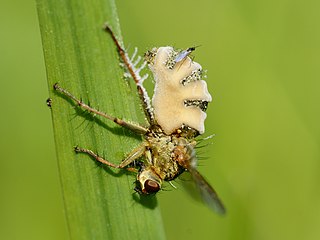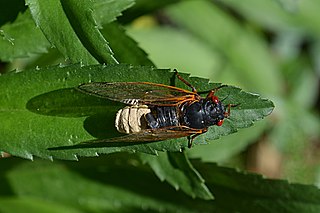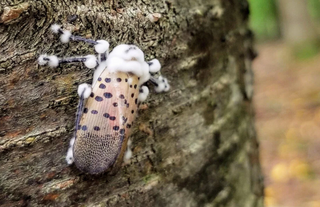
Amoebozoa is a major taxonomic group containing about 2,400 described species of amoeboid protists, often possessing blunt, fingerlike, lobose pseudopods and tubular mitochondrial cristae. In traditional and currently no longer supported classification schemes, Amoebozoa is ranked as a phylum within either the kingdom Protista or the kingdom Protozoa. In the classification favored by the International Society of Protistologists, it is retained as an unranked "supergroup" within Eukaryota. Molecular genetic analysis supports Amoebozoa as a monophyletic clade. Modern studies of eukaryotic phylogenetic trees identify it as the sister group to Opisthokonta, another major clade which contains both fungi and animals as well as several other clades comprising some 300 species of unicellular eukaryotes. Amoebozoa and Opisthokonta are sometimes grouped together in a high-level taxon, variously named Unikonta, Amorphea or Opimoda.
The Ascetosporea are a group of eukaryotes that are parasites of animals, especially marine invertebrates. The two groups, the haplosporids and paramyxids, are not particularly similar morphologically, but consistently group together on molecular trees, which place them near the base of the Cercozoa. Both produce spores without the complex structures found in similar groups.

Monadofilosa is a grouping of Cercozoa. These organisms are single-celled amoeboid protists.

The Entomophthorales are an order of fungi that were previously classified in the class Zygomycetes. A new subdivision, Entomophthoromycotina, in 2007, was circumscribed for them.

Blastocladiomycota is one of the currently recognized phyla within the kingdom Fungi. Blastocladiomycota was originally the order Blastocladiales within the phylum Chytridiomycota until molecular and zoospore ultrastructural characters were used to demonstrate it was not monophyletic with Chytridiomycota. The order was first erected by Petersen for a single genus, Blastocladia, which was originally considered a member of the oomycetes. Accordingly, members of Blastocladiomycota are often referred to colloquially as "chytrids." However, some feel "chytrid" should refer only to members of Chytridiomycota. Thus, members of Blastocladiomyota are commonly called "blastoclads" by mycologists. Alternatively, members of Blastocladiomycota, Chytridiomycota, and Neocallimastigomycota lumped together as the zoosporic true fungi. Blastocladiomycota contains 5 families and approximately 12 genera. This early diverging branch of kingdom Fungi is the first to exhibit alternation of generations. As well, two (once) popular model organisms—Allomyces macrogynus and Blastocladiella emersonii—belong to this phylum.

Entomophthora is a fungal genus in the family Entomophthoraceae. Species in this genus are parasitic on flies and other two-winged insects. The genus was circumscribed by German physician Johann Baptist Georg Wolfgang Fresenius (1808-1866) in 1856.
Olpidiaceae is a fungal plant pathogen family of genera, that was placed in the order Olpidiales.

Entomophaga is a genus of entomopathogenic fungi in the Entomophthoraceae family and also the order Entomophthorales. This has been supported by molecular phylogenetic analysis.

Pandora is a genus of fungi within the order Entomophthorales of the Zygomycota. This has been supported by molecular phylogenetic analysis.
Zoophthora is a genus of fungi in the family Entomophthoraceae. Like other taxa in this family, Zoophthora species cause disease in insects and as such are considered entomopathogenic fungi.
Erynia is a genus of fungi within the family of Entomophthoraceae and order Entomophthorales of the Zygomycota. This has been supported by molecular phylogenetic analysis.

Massospora is a genus of fungi in the Entomophthoraceae family, within the order Entomophthorales of the Zygomycota. This has been supported by molecular phylogenetic analysis.

Entomophthoraceae is a family of fungi in the order Entomophthorales. This has been supported by molecular phylogenetic analysis. Most species in the family are obligately entomopathogenic. There are two subfamilies, Erynioideae and Entomophthoroideae, which were proposed in 2005.
Strongwellsea is a genus of fungi within the order Entomophthorales of the Zygomycota. They are known to infect insects. Infected adult dipteran hosts develop a large hole in their abdomens, through which conidia (spores) are then actively discharged while the hosts are still alive.
Tarichium is a genus of fungi within the order Entomophthorales of the Zygomycota. This has been supported by molecular phylogenetic analysis.

Furia is a genus of fungi within the family of Entomophthoraceae of the Zygomycota. This has been supported by molecular phylogenetic analysis.

Batkoa is a genus of fungi within the family of Entomophthoraceae and order Entomophthorales of the Zygomycota. This has been supported by molecular phylogenetic analysis.
Eryniopsis is a genus of fungi within the family of Entomophthoraceae and order Entomophthorales of the Zygomycota. This has been supported by molecular phylogenetic analysis.
Meristacrum is a fungal genus in the monotypic family Meristacraceae, of the order Entomophthorales. They are parasites of soil invertebrates, they typically infect nematodes, and tardigrades.










